NorthEast Radio Watch 12/8/2025: Cichon’s Back in Buffalo
In this week’s issue… Veteran newsman returns - Remembering NY's Leitner, RI's Jones - CT AM saved - Maine AM moves - "Indie" adds suburban signals
Text and photos by SCOTT FYBUSH
Think of “Austin, Texas” and “public television” and what comes to mind?
If you like live music, especially with a Texas flavor, it’s Austin City Limits, the Saturday-night PBS staple, the flagship production of Austin’s public TV station, KLRU. And so we were especially excited one morning during our Austin trip in September 2017 to be able to head north from downtown past the state capitol to the University of Texas campus for a tour of KLRU and a little exploration of its history.


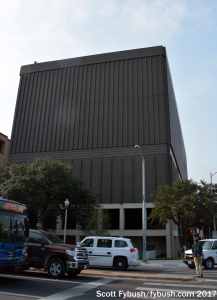
After finding parking (no easy feat on this crowded urban campus) and navigating our way to the right level of Communications Building B, we found our way to the KLRU lobby, whereupon we immediately headed upstairs to the nerve cocenter of the station.

A bit of history here: the building dates to 1974, which is also when “ACL” first went on the air – but there wasn’t a KLRU back then! Public TV for the region was provided back then by San Antonio-licensed KLRN (Channel 9), which attempted to serve both San Antonio and Austin from studios at the UT campus here in Austin and a transmitter site north of San Antonio in New Braunfels.
Once Austin had developed a full complement of UHF signals, the KLRU signal went on the air in 1979 as a full-time satellite of KLRN; a decade later, the stations completely split off into separate community licensees (by then, KLRN had moved its transmitter to a new site near China Grove, a sleepy little down down around San Antone.)
So while it’s located on the UT campus and shares its building with UT communications classes, KLRU is just a tenant in this windowless block of a structure that had been originally built for KLRN; from time to time, the station has looked at moving its facilities elsewhere, though nothing’s come of those plans yet.
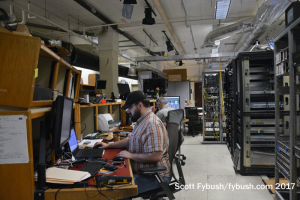

Back to the tour: the elevator ride upstairs lets us off in an alcove off KLRU’s control room, where shelves are full of vintage videotape formats containing the station’s legacy, including decades of Austin City Limits shows. (As you read this, if you’re reading it on publication day, we’re actually sitting in a panel discussion at PBS TechCon about the challenges of preserving the ACL archives.)
There are video editing suites adjacent to the master control center up here, plus a rack of STL gear for Austin’s public radio stations KUT and KUTX, about which more in a moment.

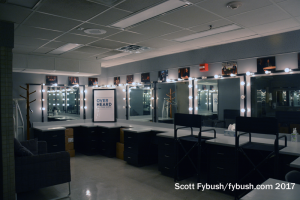
Back in to the elevator we go, and down two floors to the double-height sixth floor, where the hallway leads to two oversized studio doors. UT students have the use of one of these studios, and KLRU has the other, the legendary Studio 6A where Austin City Limits originated. “ACL” isn’t here anymore – it moved downtown in 2012 with the opening of the new purpose-built “Austin City Limits Live” venue at the Moody Theater – but the iconic skyline backdrop and audience seating are still here in this capacious studio, as is the original ACL piano, tucked away under a padded cover in one corner. (And just imagine how many musical legends used that green room!)

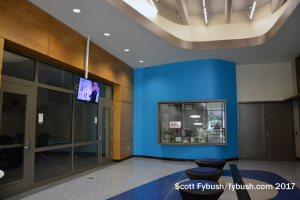
Having seen the station UT doesn’t own in the place where it no longer makes ACL, it’s time to cross the street here at the western edge of the UT campus to see the stations UT does own and which used to be sandwiched in to the middle floors of Communications Building B.
Remember our mention in last week’s installment about how Austin’s oldest AM station, now KTSN (1490), can trace its roots to UT and its early radio station, KUT, back in the mid-1920s? UT exited radio early, selling off the license in 1927, but it got back in the game in 1958 with a new educational FM license – and it persuaded the FCC to let it revive the old three-letter KUT call for the new KUT-FM, the last time the FCC would let a brand-new station sign on with a three-letter call that wasn’t already in use on a different service.
KUT-FM started on 90.7, moved to 90.5 as it grew in power in the 1980s, and along the way it traded its Quonset hut studios for the new Communications Building B when it went up in 1974. That served for 35 years – but in 2009, construction started over here on the Belo Center for New Media, with new digs for KUT anchoring the prominent northeast corner of Guadeloupe Street and Dean Keeton Street.


Today’s KUT is a multi-headed public media powerhouse: in 2013, it acquired a commercial signal (the former KXBT 98.9, licensed to Leander) and split its programming, with the main KUT-FM on 90.5 becoming full-time news and information and the station’s growing roots/AAA music programming becoming a full-time operation on 98.9, renamed KUTX.
The two stations share operations space in the big high-ceiling work area just beyond the main entrance. Unlike the windowless bunker that was Communications Building B, these new digs are full of natural light from windows on two ends. Between those windows, cubicles are shared by KUT news staffers and KUTX music programmers, with a small pod of interview studios dividing the room roughly in half and a stairwell at the south end heading up to business offices upstairs.


On the east side of this long north-south axis, there’s a music library and the doors that lead into the signature space here, the performance studio dubbed “Studio 1A.” This room, too, is filled with light from windows that look out to a small plaza along Dean Keeton Street; there’s a projector that can send video out there, too.
At one end of studio 1A, a blue-framed floor-to-ceiling window looks into the control room that anchors one corner of the studio complex.

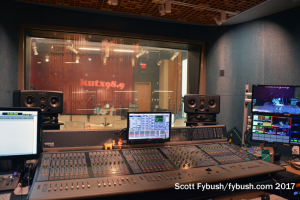
Across the open workspaces, another line of studios occupies the west side of the building, facing Guadeloupe Street; here we find Axia-equipped control rooms for KUTX and KUT.


Those stripes on the studio pod in the middle of the open workspace? Those are pictures from KUT’s history, interlaced with a running list of major donors to the station, which seems like a neat way to acknowledge funders. Keep heading toward the back of the room, which functions as the KUT newsroom, and the space turns into an L shape as it bends to the east past a kitchen and a row of edit bays.


At the far end of the L, there’s one more studio-control room pair, this one designed for live talk. Here we find the “Texas Standard” talk show underway (it’s a co-production of KUT and sister stations in San Antonio, Dallas and Houston), with its studio neatly framed in that window visible from the main lobby of the Belo building. Scroll back up and you can see the blue-framed studio window, adjacent to the separate entrance to KUT’s community room, which can be used by the station itself or other groups that need a meeting place.
So where are the rest of the market’s TV stations and TV/FM transmitters? Stay tuned for our third and final installment of pictures from our Austin visit, next week!
Thanks to KLRU’s Sara Robertson and KUT/KUTX’s Hawk Mendenhall for the tours!

As we announced a few weeks ago, the 2026 edition of the Tower Site Calendar will be the last.
We began publishing it 25 years ago, and the broadcast landscape is radically different now.
Radio World just ran an excellent article about us if you want to know more.
Once it’s gone, that’s it. We won’t be printing any more.
Thank you to everyone who saw our announcement and rushed to buy it. We appreciate you.
(There are some calendars from previous years if you want more of a tower photo fix — all under $5.)
But don’t wait to get this year’s Tower Site Calendar — buy it now!
We are selling the Broadcast Historian’s Calendar again this year, but we have that in an even smaller quantity — definitely don’t hesitate for that.
And visit the Fybush Media Store to check out our selection of books and videos, too!
And don’t miss a big batch of Austin IDs next Wednesday, over at our sister site, TopHour.com!
Next week: Austin part III – The TV Stations
In this week’s issue… Veteran newsman returns - Remembering NY's Leitner, RI's Jones - CT AM saved - Maine AM moves - "Indie" adds suburban signals
In this week’s issue… Scripps stations face takeover - Sinclair moves more affiliations - CT stations sold - Maine AM surrendered - Remembering WVBR's Shapiro, WABC's Morgan
In this week’s issue… CT TV legend succumbs to cancer - Remembering PA's Adams - FCC still stalled by shutdown - Pittsburgh morning host exits
In this week’s issue… FCC faces reopening challenges - Veteran Boston anchor retires - Morning shift in Toronto - NYC FMs expand reach